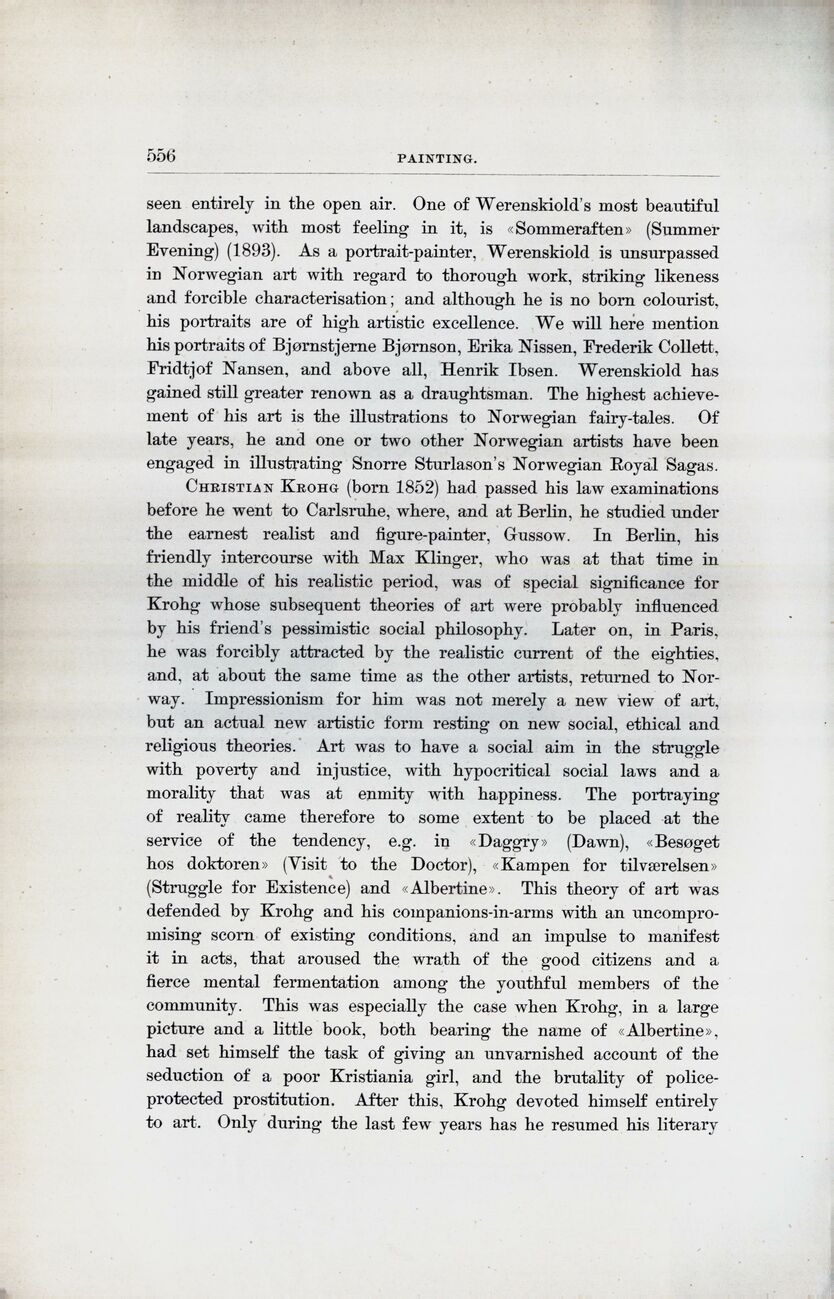
Full resolution (JPEG) - On this page / på denna sida - Painting, by Jens Thiis

<< prev. page << föreg. sida << >> nästa sida >> next page >>
Below is the raw OCR text
from the above scanned image.
Do you see an error? Proofread the page now!
Här nedan syns maskintolkade texten från faksimilbilden ovan.
Ser du något fel? Korrekturläs sidan nu!
This page has been proofread at least once.
(diff)
(history)
Denna sida har korrekturlästs minst en gång.
(skillnad)
(historik)
seen entirely in the open air. One of Werenskiold’s most beautiful
landscapes, with most feeling in it, is «Sommeraften» (Summer
Evening) (1893). As a portrait-painter, Werenskiold is unsurpassed
in Norwegian art with regard to thorough work, striking likeness
and forcible characterisation; and although he is no born colourist,
his portraits are of high artistic excellence. We will here mention
his portraits of Bjørnstjerne Bjørnson, Erika Nissen, Frederik Collett,
Fridtjof Nansen, and above all, Henrik Ibsen. Werenskiold has
gained still greater renown as a draughtsman. The highest
achievement of his art is the illustrations to Norwegian fairy-tales. Of
late years, he and one or two other Norwegian artists have been
engaged in illustrating Snorre Sturlason’s Norwegian Royal Sagas.
Christian Krohg (born 1852) had passed his law examinations
before he went to Carlsruhe, where, and at Berlin, he studied under
the earnest realist and figure-painter, Gussow. In Berlin, his
friendly intercourse with Max Klinger, who was at that time in
the middle of his realistic period, was of special significance for
Krohg whose subsequent theories of art were probably influenced
by his friend’s pessimistic social philosophy. Later on, in Paris,
he was forcibly attracted by the realistic current of the eighties,
and, at about the same time as the other artists, returned to
Norway. Impressionism for him was not merely a new view of art,
but an actual new artistic form resting on new social, ethical and
religious theories. Art was to have a social aim in the struggle
with poverty and injustice, with hypocritical social laws and a
morality that was at enmity with happiness. The portraying
of reality came therefore to some extent to be placed at the
service of the tendency, e.g. in «Daggry» (Dawn), «Besøget
hos doktoren» (Visit to the Doctor), «Kampen for tilværelsen»
(Struggle for Existence) and «Albertine». This theory of art was
defended by Krohg and his companions-in-arms with an
uncompromising scorn of existing conditions, and an impulse to manifest
it in acts, that aroused the wrath of the good citizens and a
fierce mental fermentation among the youthful members of the
community. This was especially the case when Krohg, in a large
picture and a little book, both bearing the name of «Albertine»,
had set himself the task of giving an unvarnished account of the
seduction of a poor Kristiania girl, and the brutality of
police-protected prostitution. After this, Krohg devoted himself entirely
to art. Only during the last few years has he resumed his literary
<< prev. page << föreg. sida << >> nästa sida >> next page >>